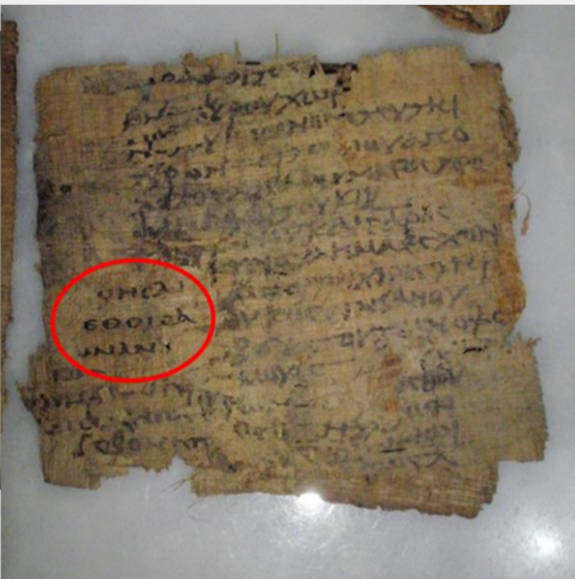I continue to unpack various parts of Ariel Sabar’s informative article in The Atlantic. One of the things that originally piqued the curiosity of many of us about the Green Collection was their seemingly endless supply of “cartonnage,” a term used to describe both mummy casings made of waste papyrus and the waste papyrus that was sometimes use to stiffen the leather covers of ancient books (for the development of the term, see my earlier discussion). The Green Collection seemed to have a wealth of pieces, and Scott Carroll became famous largely by claiming to have extracted New Testament papyri from them. Even though it now seems that Carroll’s claims were just lies, the question of the source of all this “cartonnage” material remains. The Green Collection had both mummy masks and “other” cartonnage.
First the mummy masks. Mike Holmes had previously reported that the Green Collection had eight mummy masks, four of which had been purchased from Professor Obbink. Sabar’s reporting now significantly raises these numbers:
“…It was one of some 20 masks Obbink sold the Greens. A source who has seen the figures told me that on top of the $4 million to $8 million he charged for papyri, the family paid him $1 million to $2 million for a host of other antiquities.”
In addition, the article introduces another fact that may or may not relate to the masks that Professor Obbink allegedly sold to the Green Collection:
“Obbink had once kept hundreds of Oxford’s uncataloged mummy masks in his rooms, as a favor to the university, which was short on storage.”
This last statement raises a couple questions: 1) I wonder if this was the period of time when this sequence of Alamy photos was taken (the credits in the photos say that they were taken in 2005):

And 2) Were the masks in Professor Obbink’s care really “Oxford’s uncataloged mummy masks” or were they the property of the Egypt Exploration Society? Note the presence of the characteristic metal boxes used for EES items in the background of these photos. And while we’re on the topic of the background of these photos: The recycling of old wholesale cat food boxes is admirable from an environmental standpoint, but they might not be the best method for storing delicate 2,000 year-old artifacts. And the classification system (“HEADS”) does not seem sufficiently precise for differentiating among the artifacts:

It is also worth recalling that back in 2014, Scott Carroll stated that Oxford University was one of his sources for acquiring mummy masks.
While these masks constitute one side of the Green Collection’s cartonnage collection, Sabar’s article also offers some insight into the second related but different set of material in their collection–the “other” cartonnage. Among the purchases made by Hobby Lobby were oddly shaped masses of inscribed papyri. These were not parts of mummy casings. Nor do they look like parts of the papyrus pasteboard sometimes used to construct the leather covers of books (see more details about this phenomenon here). They were just randomly shaped wads of inscribed papyrus stuck together. Carroll once aptly classified them as “thingamajigs.”
As Mike Holmes noted in an earlier post, at least some of the Green Collection Sappho fragments that Scott Carroll pretended to remove from a mummy mask actually came from one of these nondescript chunks:

Sabar has uncovered some surprising new information in this regard. It comes, however, from a not-entirely-reliable source, Yakup Eksioglu, a.k.a., MixAntik, the Turkish dealer who is revealed to be the previous owner of the Sappho fragments.
“In a WhatsApp chat this February, Eksioglu told me that he was, indeed, the source for all the Sappho fragments—the 20 small pieces ‘discovered’ at Baylor, and the large sheet with the two new poems. The claim that they had come from cartonnage purchased at a Christie’s auction in 2011 was a ‘fake story,’ he said. When I asked why some of the pieces looked, in photos, like they had been embedded in cartonnage, he suggested that they had been staged: ‘This is a very simple method, you can do it by wetting.'”
As I said, the source is not entirely reliable. But what he says would go a long way toward explaining the bizarre “thingamajigs” Scott Carroll sometimes displayed. There was, for example, the strange cartonnage circle (said to have been bought from a dealer in Istanbul) that very conveniently had the first page of a codex of 1 Samuel right on top:

And then there was the “Demosthenes,” again, right on top of the clump:

If Mr. Eksioglu is being truthful about having manufactured these “cartonnage” clumps himself, then the question arises of where he got the idea to do so (it’s not exactly an intuitive thing to do with ancient manuscripts). And of course there remains the question of where he obtained all these papyri in the first place. Sabar’s article provides some clues there as well, but that is a separate post.


The phrase that immediately struck me was “family collection”, After all, the Genovese family is a “family” too…
It might be interesting to contact the photographer Geraint Lewis https://geraintlewis.com/ to see what other images he has from that Alamy/Guardian shoot, and whether he can confirm the date.
Hi Brent thank you for this post. The practice of glueing together small papyrus fragments in order to obtain larger pieces thought to be more appealing to prospective buyers is not new similarly to the construction of fake scrolls that you might find appearing for sale sometimes. In my Whatsapp exchanges with YE I was sent sort of papyrus collages too.
As you know, I have asked to be sent the original digital images of the Sappho pastiche in order to have a better sense of the object, but that request was declined. There are a lot of open questions on how and when the S. and other fragments were mounted, dismounted etc.